The NVIDIA GeForce GTX 780 Ti Review
by Ryan Smith on November 7, 2013 9:01 AM ESTCompute
Jumping into compute, we’re entering the one area where GTX 780 Ti’s rule won’t be nearly as absolute. Among NVIDIA cards its single precision performance will be unchallenged, but the artificial double precision performance limitation as compared to the compute-focused GTX Titan means that GTX 780 Ti will still lose to GTX Titan whenever double precision comes into play. Alternatively, GTX 780 Ti still has to deal with the fact that AMD’s cards have shown themselves to be far more competitive in our selection of compute benchmarks.
As always we'll start with our DirectCompute game example, Civilization V, which uses DirectCompute to decompress textures on the fly. Civ V includes a sub-benchmark that exclusively tests the speed of their texture decompression algorithm by repeatedly decompressing the textures required for one of the game’s leader scenes. While DirectCompute is used in many games, this is one of the only games with a benchmark that can isolate the use of DirectCompute and its resulting performance.
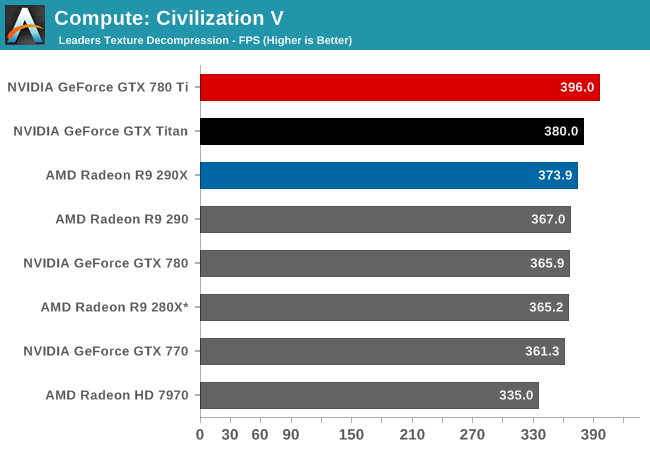
Even though we’re largely CPU bound by this point, GTX 780 Ti manages to get a bit more out of Civilization V’s texture decode routine, pushing it to the top of the charts and ahead of both GTX Titan and 290X.
Our next benchmark is LuxMark2.0, the official benchmark of SmallLuxGPU 2.0. SmallLuxGPU is an OpenCL accelerated ray tracer that is part of the larger LuxRender suite. Ray tracing has become a stronghold for GPUs in recent years as ray tracing maps well to GPU pipelines, allowing artists to render scenes much more quickly than with CPUs alone.
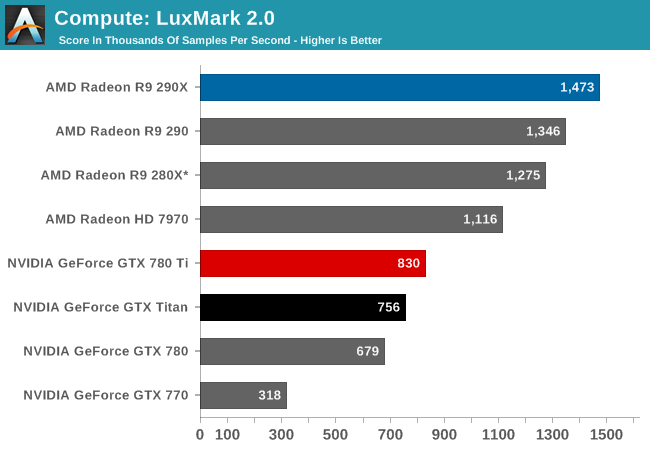
With LuxMark NVIDIA’s ray tracing performance sees further improvements due to the additional compute resources at hand. But NVIDIA still doesn’t fare well here, with the GTX 780 Ti falling behind all of our AMD cards in this test.
Our 3rd compute benchmark is Sony Vegas Pro 12, an OpenGL and OpenCL video editing and authoring package. Vegas can use GPUs in a few different ways, the primary uses being to accelerate the video effects and compositing process itself, and in the video encoding step. With video encoding being increasingly offloaded to dedicated DSPs these days we’re focusing on the editing and compositing process, rendering to a low CPU overhead format (XDCAM EX). This specific test comes from Sony, and measures how long it takes to render a video.

Like LuxMark, GTX 780 Ti once again improves on its predecessors. But it’s not enough to make up for AMD’s innate performance advantage in this benchmark, leading to GTX 780 Ti trailing all of the AMD cards.
Our 4th benchmark set comes from CLBenchmark 1.1. CLBenchmark contains a number of subtests; we’re focusing on the most practical of them, the computer vision test and the fluid simulation test. The former being a useful proxy for computer imaging tasks where systems are required to parse images and identify features (e.g. humans), while fluid simulations are common in professional graphics work and games alike.
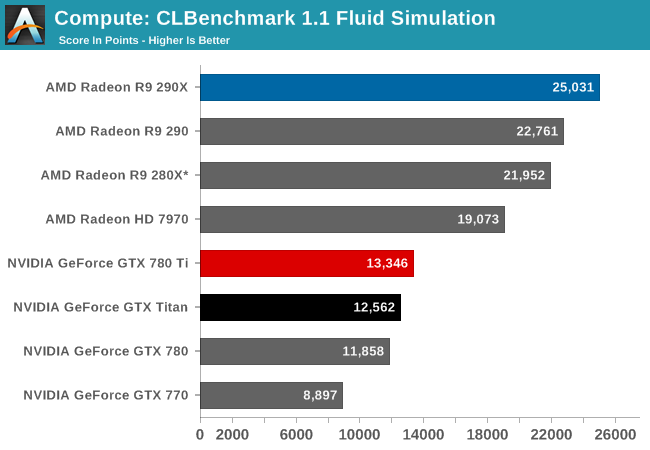
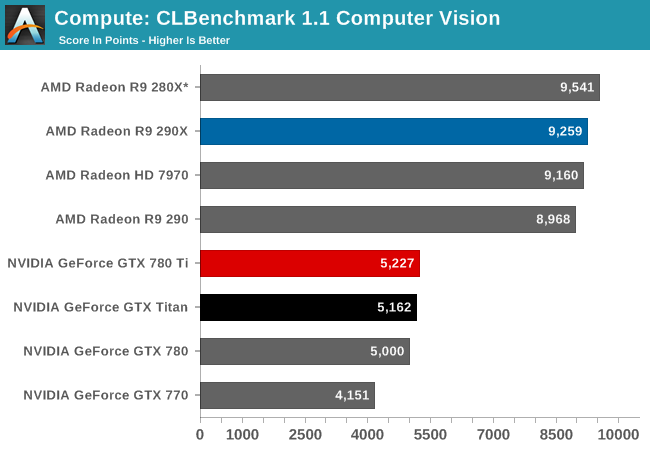
CLBenchmark continues to be the same story. GTX 780 Ti improves on NVIDIA’s performance to become their fastest single precision card, but it still falls short of every AMD card in these tests.
Moving on, our 5th compute benchmark is FAHBench, the official Folding @ Home benchmark. Folding @ Home is the popular Stanford-backed research and distributed computing initiative that has work distributed to millions of volunteer computers over the internet, each of which is responsible for a tiny slice of a protein folding simulation. FAHBench can test both single precision and double precision floating point performance, with single precision being the most useful metric for most consumer cards due to their low double precision performance. Each precision has two modes, explicit and implicit, the difference being whether water atoms are included in the simulation, which adds quite a bit of work and overhead. This is another OpenCL test, as Folding @ Home has moved exclusively to OpenCL this year with FAHCore 17.

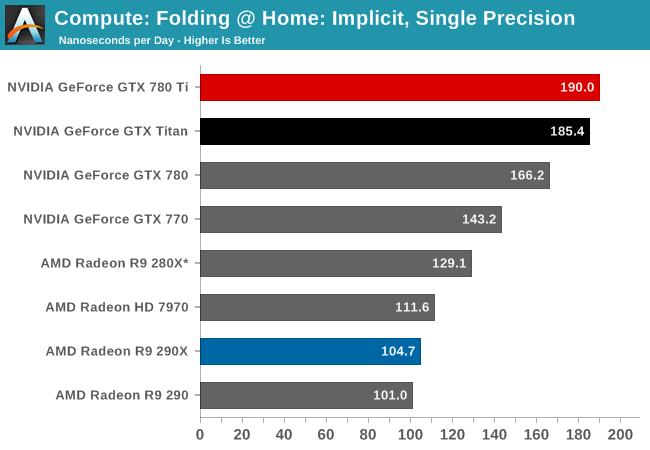
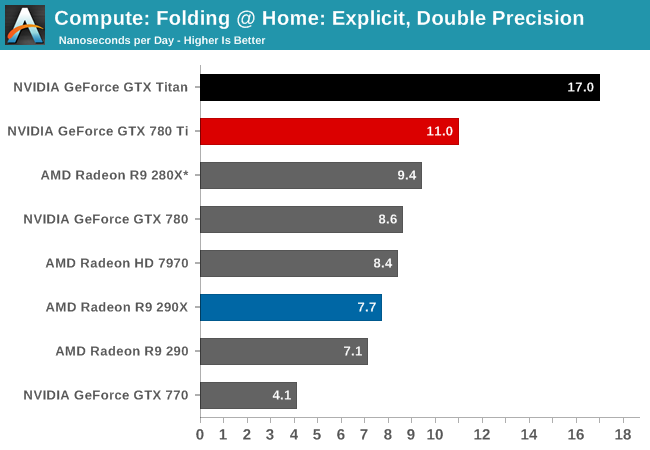
Finally with Folding@Home we see the GTX 780 Ti once again take the top spot. In the single precision tests the GTX 780 further extends NVIDIA’s lead, beating GTX Titan by anywhere between a few percent to over ten percent depending on which specific test we’re looking at. However even with GTX 780 Ti’s general performance increase, in the double precision test it won’t overcome the innate double precision performance deficit it faces versus GTX Titan. When it comes to double precision compute, Titan remains king.
Wrapping things up, our final compute benchmark is an in-house project developed by our very own Dr. Ian Cutress. SystemCompute is our first C++ AMP benchmark, utilizing Microsoft’s simple C++ extensions to allow the easy use of GPU computing in C++ programs. SystemCompute in turn is a collection of benchmarks for several different fundamental compute algorithms, as described in this previous article, with the final score represented in points. DirectCompute is the compute backend for C++ AMP on Windows, so this forms our other DirectCompute test.
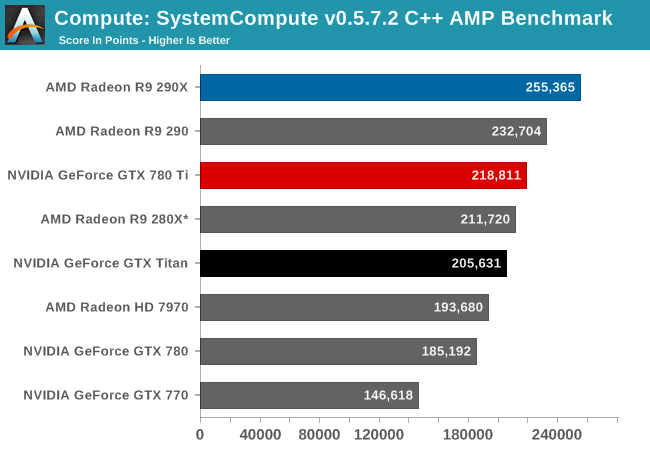
Last, in our C++ AMP benchmark we see the GTX 780 Ti take the top spot for an NVIDIA card, but like so many of our earlier compute tests it will come up short versus AMD’s best cards. This isn’t quite as lopsided as some of our other tests, however GTX 780 Ti is stuck competing with the 280X while the 290 and 290X easily outperform NVIDIA’s new flagship.










302 Comments
View All Comments
1Angelreloaded - Thursday, November 7, 2013 - link
Physically the 780 and 780 TI are literally the same unit, minus minor things. The difference is the neutered chip, and OC'd VRAM, Which means your paying for the same unit at 2 completely different prices, in fact, How much does it cost to disable the SMX texture? So shouldn't the overhead on the original unit be higher with more work having to be done? Or like AMD tricore are we paying for defective chips again ?TheJian - Thursday, November 7, 2013 - link
Wrong. They have been saving DEFECT FREE GK110 units for months just to be able to launch this with good quantity (probably only started having better results at B1, which all of these are). I doubt that there are many 780's that have fully working units that are disabled. They are failed Tesla chips (you can say DP is disabled on purpose, but not the SMX's). Do you really think 550mm chips have a ZERO defect rate?...LOL. I would be surprised if the first runs of Titan had any more working SMX's too as they were directly failed Tesla's. Sure there are probably a few cards with some working that are disabled but Yields and history say with chips this big there just has to be a pretty high defect rate vs. 100% working chips. It is pretty much the largest chip TSMC can make. That's not easy. Both AMD and NV do this to salvage failed chips (heck everybody does). You come with a flagship, then anything that fails you mark as a lower model (many models). It allows you to increase your yield and chips that can be sold. You should be thankful they have the tech to do this or we'd all be paying FAR higher prices do to chucking chips by the millions in the trash.TheJian - Thursday, November 7, 2013 - link
http://www.tomshardware.com/reviews/geforce-gtx-78..."Not to be caught off-guard, Nvidia was already binning its GK110B GPUs, which have been shipping since this summer on GeForce GTX 780 and Titan cards. The company won’t get specific about what it was looking for, but we have to imagine it set aside flawless processors with the lowest power leakage to create a spiritual successor for GeForce GTX 580. Today, those fully-functional GPUs drop into Nvidia’s GeForce GTX 780 Ti."
There, don't have to believe me...confirmed I guess ;)
beck2448 - Thursday, November 7, 2013 - link
Great job Nvidia! I think the partners with custom cooling will get another 15 to 20 % performance out of it with lower temps and less noise, and that is insane for a single GPU. Can't wait to see the Lightning and Windforce editions.aznjoka - Thursday, November 7, 2013 - link
The crossfire scaling on the 290x is much better than the 780ti. If you are running a dual card set up, getting a 290x is pretty much a no brainer.beck2448 - Thursday, November 7, 2013 - link
from Benchmark reviews: In conclusion, GeForce GTX 780 Ti is the gamer’s version of GTX TITAN with a powerful lead ahead of Radeon R9 290X. Even if it were possible for the competition to overclock and reach similar frame rate performance, temperatures and noise would still heavily favor the GTX 780 Ti design. I was shocked at how loud AMD’s R9 290X would roar once it began to heat up midway through a benchmark test, creating a bit of sadness for gamers trying to play with open speakers instead of an insulated headset. There is a modest price difference between them, but quite frankly, the competition doesn’t belong in the same class.Read more at http://benchmarkreviews.com/8468/nvidia-geforce-gt...
1Angelreloaded - Thursday, November 7, 2013 - link
TBH the stock Nvidia cooler isn't that much better either they tend to run a lot hotter than ACX/Twin Frozer, and other such solutions, so both have cooling headroom, Hawaii though is just plain ridiculous.deedubs - Thursday, November 7, 2013 - link
Noticed the graph for shadowplay performance has its labels reversed. It makes it look like SP increases performance instead of decreasing.Ryan Smith - Thursday, November 7, 2013 - link
Whoops. Thanks for that. The multi-series graph tool is a bit picky...Filiprino - Thursday, November 7, 2013 - link
I don't see NVIDIA as a real winner here, really. Their margin is very tight, and AMD drivers still have to mature, and when you talk about crossfire, AMD is doing clearly better, for $200 less and 6dB more.